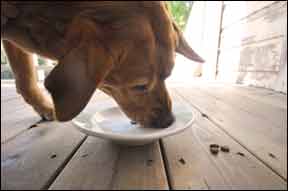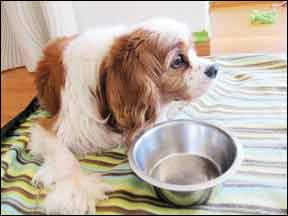As discussed in “Canine Diabetes,” WDJ May 2012, dogs with this disease require blood sugar monitoring, daily insulin injections, carefully planned meals, and scheduled exercise. Fortunately, most cases can be managed at home, and once their medication and diet are stabilized, affected dogs live just as long and actively as other dogs. The most important factor in choosing a diet for a dog with diabetes is that he likes the food and eats it willingly every day.
We’ll say it again: There is no single “best” diet for dogs with diabetes. Most diabetic dogs do fine on a diet formulated for adult maintenance. And most do not require a high-fiber prescription diet. However, it is important to maintain consistent carbohydrate levels, and a diet moderately low in fat may be safest. The nutritional needs of any concurrent disease should take precedence.

Dogs with diabetes can thrive on diets that are dry or canned, prescription, frozen raw, home-prepared (cooked or raw), and combinations of any of these. See the samples below (starting with “Prescription Diets”) for a variety of diets that have worked well for diabetic dogs and their caregivers.
To help determine your diabetic dog’s best diet, consider the following guidelines. (See “Calculating a Diet’s Protein, Fat, Carbs, and Fiber,” to learn how to figure out how much of each macronutrient you’re feeding.)
Fat – Because undiagnosed pancreatitis is common in diabetes patients, many veterinarians recommend feeding diabetic dogs less than 30 percent of their calories from fat. This is equivalent to about 14 percent fat on a dry matter (DM) basis, or 35 grams of fat per 1,000 calories (GFK). These guidelines are appropriate for dogs with Cushing’s disease, or whose blood tends to be lipemic (fatty), or who are prone to digestive upset.
For some dogs with chronic pancreatitis or persistent fasting hyperlipidemia (high blood triglycerides or cholesterol), fat may need to be reduced to less than 20 percent of calories (about 9 percent fat DM, or 23 GFK).
Underweight dogs usually need more fat. Higher fat foods also reduce postprandial glycemia (rises in blood sugar after meals), probably because they slow gastric emptying. Diabetic dogs without concurrent illness requiring limited fat may be fed up to 20 percent fat DM (40 percent of calories from fat; 47 GFK).
Since dogs love the taste of fat, it’s often added to food to improve palatability, but for dogs with diabetes, flavoring agents like low-fat chicken or beef broth are better choices.
If your dog requires a low-fat diet, see “Healthy Low-Fat Diets,” WDJ December 2008, for more details.
Protein – It is important to feed enough highly digestible, high-quality protein – at least 18 to 25 percent on a dry matter basis – to reduce muscle catabolism (breakdown). Such diets do not appear to increase the risk of diabetic nephropathy (kidney disease). There are no negative effects associated with providing at least 30 to 45 percent of calories from protein (about 35 to 50 percent protein DM).

288
Carbohydrates – Carbs are key ingredients in any diabetic dog’s diet. The amount of carbohydrate should remain consistent so that the dog’s insulin needs remain stable. Complex carbs, especially barley and sorghum, are recommended, while simple carbs such as white rice and corn syrup should be avoided.
Starch (the digestible portion of carbohydrates) is best limited to less than 50 percent of calories (about 55 percent DM), and diabetic dogs may do better when starch is less than 30 percent of calories (about 33 percent DM). If the amount of starch in the diet changes, the amount of insulin will need to be adjusted as well.
Fiber – There are two types of fiber, soluble and insoluble. Both types slow gastric emptying and carbohydrate digestion, reducing postprandial glucose spikes. Soluble fiber feeds the body’s beneficial bacteria and supports the immune system, but it can also cause gas and loose stools. Insoluble fiber (roughage) increases stool volume, regulates intestinal transit time, is generally well tolerated, and may help with glucose control.
Whole grains are decent sources of both soluble and insoluble fiber. Barley, bulgur wheat, long-grain brown rice, whole wheat pasta, rolled oats, quinoa, beans, and peas are good choices for providing starch and fiber. The flesh of vegetables and fruit also supply soluble fiber, while the skins are a good source of insoluble fiber. Sweet potatoes with skin offer a particularly high nutrition and fiber content without sending blood sugar soaring.
If you are feeding a maintenance (non-prescription) diet and having poor glycemic control, try feeding more insoluble or mixed fiber. Many dogs have improved glucose control with more fiber, while some do better with less. Too much fiber can lead to gas, diarrhea or constipation, weight loss, poor coat, and an unwillingness to eat. Recommendations vary, but generally 8 to 15 percent DM, or 25 to 35 grams of fiber per 1,000 calories, would be considered a moderate amount of fiber.
Note that dietary fiber is not the same as crude fiber shown on dog food labels, which is not a useful measure. Most foods contain a lot more fiber than the labels indicate. Unfortunately, there is usually no way to know how much dietary fiber non-prescription foods contain. You can only look for ingredients known to supply fiber.
–Bran, cellulose, pea fiber, tomato pomace, and hulls of any kind (including “soybean mill run”) supply mostly insoluble fiber.
–Fructo-olicosaccharides (FOS), guar gum, and pectin provide soluble fiber.
–Beet pulp has both types of fiber.
Fiber supplements can be used to add fiber if needed. Benefiber (wheat dextrin) and Hydrocil (psyllium) contain mostly soluble fiber, while Citrucel contains insoluble fiber (methylcellulose).

Customizing the Diet
Preparing your dog’s food at home is the easiest way to feed a customized diet, but many owners obtain good results by mixing wet and dry foods or by combining fresh foods with commercially prepared diets.
For example, many low-fat commercial diets are also low in protein, with high levels of carbohydrates. Ingredients such as lean meat, skinless poultry, fish, eggs, and yogurt can be used to replace a portion of the commercial diet to increase protein and reduce carbohydrates in the overall diet. If you’re feeding a high-protein, low-carb, low-fiber commercial diet, adding high-fiber fresh foods or fiber supplements may help with glycemic control.
Dry food decreases hyperglycemia (high blood sugar) after eating because it takes longer to digest, while wet food may encourage the dog to eat well and increase fluid intake. Do not feed commercial moist or semi-moist foods or treats, as they almost always contain added sugars (e.g., propylene glycol).
In some patients, dry food takes too long to digest, so that its assimilation does not coincide with the insulin’s peak effect. In that case, presoaking the food or grinding it to a powder before feeding, or reducing the amount of fiber in the diet, will speed digestion.
If a too-thin dog fails to gain weight, you may need to feed more food, increase the amount of fat, or decrease the amount of fiber in the diet.
If the patient suddenly refuses food, see your veterinarian to check for a concurrent illness. Do not continue to give insulin to a dog who is not eating.
Textbook Recipes
Two sample recipes provided in the Encyclopedia of Canine Clinical Nutrition (Pibot et al., 2006) each provide about 1,700 calories, the amount needed for a typical active 70-pound dog. Each 1,000-gram (2.2-pound) recipe uses:
500 to 600 grams of low-fat meat and dairy (fish, skinless turkey breast, creamed cottage cheese)
–250 to 270 grams (dry measure) of starchy carbs (whole wheat pasta, rolled oats)
–60 to 150 grams of cooked carrots
–50 to 60 grams of wheat bran (insoluble fiber)
–10 grams pectin (soluble fiber)
–10 to 15 grams canola oil
–plus a multivitamin and mineral supplement (including about 2,500 mg calcium)
These recipes are 33-34 percent protein, 10-11 percent fat, 38-41 percent starch, and 12-14 percent fiber on a dry matter basis.
Prescription Diets
Commerical prescription diets meant for dogs with diabetes work for some dogs, with or without added foods. These diets are generally low in protein and fat, and high in fiber and carbohydrates. They are unsuitable for dogs who need to gain weight, but the high fiber can help some dogs whose diabetes is difficult to regulate. These diets can be combined with other foods to increase protein and fat.

Genny and Buster are two diabetic dogs who eat prescription diets.
Genny, a 10-year-old Bichon Frise, has lived with Cathy Briody in Jewett City, Connecticut, since Genny was given up for adoption at age 15 months because of diabetes. “She spent her first few days with me at Tufts Veterinary Hospital getting regulated,” says Briody. “Her vet recommended Hill’s Prescription Diet w/d canned food twice a day, 12 hours apart, followed by an insulin shot 30 minutes later. I did a glucose curve on her at home every two weeks, then faxed the results to her vet at Tufts, and he would call to let me know what changes to make in her amounts of food and insulin.”
Regulating Genny’s condition took two months, at the end of which Briody, a rescue volunteer, realized she couldn’t let the pup go to anyone else. Genny’s foster home became her permanent residence.
“She celebrated her tenth birthday last November,” says Briody. “She still eats w/d, only now she gets three meals a day because her glucose tends to get low in the afternoon, and she won’t eat breakfast unless Parmesan cheese is sprinkled on her food. Genny has had two hypoglycemic crashes. The first was in 2005, when she had a seizure. She got lots of Karo syrup and food before going to her regular vet and spending the rest of the weekend back at Tufts. Her second crash happened last August, and her recovery was a long process, but she has been fine since October.”
Genny is a Delta Society Pet Partners therapy dog who visits a hospital and two group homes every month, as well as a Reading Education Assistance Dog (R.E.A.D.) who is read to by first-graders once a week. “Although I would like to feed her a better food,” says Briody, “the w/d works fine for Genny, and she eats it willingly. She does not take any supplements and seems to be doing well.”
Buster, a 13-year-old, seven-pound Maltese (pictured taking agility jumps in last month’s article on diabetes), also eats a prescription diet, with some raw food added to it. Buster lives with Mary Butler in Northern California. “As soon as he was diagnosed three years ago,” says Butler, “I consulted a nutrition specialist at the University of California, Davis, veterinary school, who took a detailed history and calculated Buster’s nutritional needs. In addition to including my little guy’s favorite snack (Nature’s Variety Instinct raw beef medallions), he recommended a diet of high-fiber Hill’s Prescription Diet w/d.” Like most commercial raw diets, Instinct raw foods are high in protein and fat and low in carbs, a good complement to w/d’s low protein and fat and high carbs.
Butler feeds Buster the same thing every morning and evening. “He gets less than ¼ cup of dry w/d chicken plus half of a beef medallion,” she says. “The vet told me the most important thing is to be consistent with his diet, and I have been. Buster has been stable ever since his diagnosis. He gets insulin twice a day, and the dose has remained the same as the day he was diagnosed. It has never had to be adjusted.”
Buster loves his meals and always eats every bite, says Butler. “He hops and spins when I say, ‘Supper!’ I will not change a thing I’m doing as he is so stable and healthy.”
Non-Prescription Dry and Canned Foods
Diabetic dogs don’t require a prescription diet. Adult maintenance diets with moderate amounts of fiber work well for most dogs with diabetes. Penny and Silkie are great examples of dogs who thrive on high-quality commercial diets.
Penny, a 35-pound, 6-year-old Brittany belonging to Melba and Curtiss Lanham of Fulshear, Texas, is a diabetes success story. “We took Penny in as a foster when she was six months old,” says Melba. “She was the most full-of-energy Brittany we had ever fostered and was also the smartest little girl. It wasn’t long before she was a permanent member of our family.”
But at nine months, Penny’s personality changed. “She did not like to be around the other dogs and kept them away from her. Normally a very playful puppy, she would often hide under a desk or wrap herself tightly in a little ball. Her trips outside to void urine increased but with no noticeable increase in water intake. Off to our favorite veterinarian she went.”
Penny was diagnosed with a urinary tract infection, but antibiotics didn’t change her behavior or symptoms. Back she went for more tests, only this time Penny wasn’t allowed to leave until her very high blood sugar stabilized. She had diabetes.
“Curtiss and I were both licensed Texas paramedics,” says Melba, “so drawing blood, using a glucometer, giving injections, and even understanding the disease were the easy parts of the journey. Managing Penny’s diet became the biggest challenge.”

After experimenting with different diets, the Lanhams found that Penny had most consistent results with Nature’s Logic Chicken dry kibble, which has 38 percent protein and 18 percent fat DM according to the analysis posted on the company’s website. “We have over four years of blood draws and glucometer readings for Penny to show the consistency this food has provided. We add 1 tablespoon of canned Nature’s Variety Instinct Venison to her moistened kibble each feeding.” Instinct grain-free canned foods are 95 percent meat and liver, high in protein and fat, and very low in carbs.
Penny’s insulin dose may need adjusting if her meals are served later than usual or if she hasn’t gotten her normal exercise because of inclement weather. “Heaven forbid if we have company and it’s someone who doesn’t understand that Penny is not allowed snacks, as she is just too darned cute not to feed!” says Melba. “But because we monitor so closely and know all of her pre-crisis signs, we are able to avoid the most drastic swings in her blood sugar level.
“This little juvenile diabetic is now almost six years old. She is a very fit Brittany, still full of energy and extremely active. She is bright-eyed, plays hard with our other three dogs, runs the ¼ acre we have fenced in the back, and watches squirrels with a passion. She is still the smartest Brittany we have ever had.”
Silkie, a 14-year-old, 18-pound Silky Terrier belonging to Meri Binette of Delray Beach, Florida, has lived with diabetes since November 2010. He was also diagnosed with hypothyroidism. Cataract surgery with lens implants followed in April 2011 and, because of demodectic mange, he had to be treated with high doses of ivermectin.
“Silkie also has on-and-off colitis,” says Binette, “so we consulted with a holistic nutritionist for animals. We try to keep Silkie’s protein levels high, with carbs lower, and keep treats to a minimum. We give him fish oil and digestive enzymes. We do home blood glucose tests because his insulin dose requirement always changes.” Silkie was switched from Humulin to long-acting Levemir because he has been difficult to regulate.
Silkie eats Natural Balance “limited ingredient” venison, bison, or fish (canned and dry), plus Stella and Chewy’s freeze-dried duck or lean ground beef or turkey as a treat. Natural Balance limited-ingredient diets are formulated for dogs with food allergies. They are mostly grain-free, low in fat, with limited protein, and high carbs. As with most commercial foods, the canned versions have more protein and fat than the dry. Stella & Chewy’s frozen and freeze-dried foods are high in protein, high in fat, and low in carbs.
All of Silkie’s foods are low in fiber, so Binette recently began adding 2 tablespoons of Hill’s r/d high-fiber canned food. “It makes his poops more solid, and more frequent, so less gas,” says Binette, “His glucose levels have also been more stable. At age 14, we just want his quality of life to be good. So far, it is. We take it day by day.”
Combining Homemade and Commercial Diets
Commercial diets can be improved with the addition of raw or cooked foods, while feeding part kibble or canned in addition to home-prepared can make preparation easier. Scout, Henry, Buddy, and Kodi each receive a customized diet containing all kinds of foods – a diet that was found by trial and error to work well for each individual.
Scout, an eight-year-old Bichon/Shih Tzu mix, who lives with Diane Di Salvo of Madison, Wisconsin, was diagnosed with diabetes two years ago.
“That’s when I joined the Yahoo ‘DiabetesPet’ group (groups.yahoo.com/group/diabetespet),” says Di Salvo. “The great people there have a wealth of knowledge gained over many years of trial and error. The basic recommendation for homemade food is 1/3 protein (lean chicken breasts, lean ground beef, lean turkey), 1/3 veggies (green beans, cauliflower, summer squash), and 1/3 complex carbohydrates (brown rice, barley, quinoa, oatmeal). In addition, a multivitamin, calcium, and fish oil are recommended.”
After six months, Di Salvo found the food preparation too time-consuming, so she replaced the diet’s complex carbs with Wellness CORE Reduced Fat dog food, which is popular among group members. “I used equal parts kibble and our original chicken/veggie mix. This worked very well for Scout, and I had no difficulty controlling her blood glucose. But after a month, she decided she didn’t like the CORE food and would only eat her chicken and veggies. So we made another switch, this time to Orijen Senior, which we fed half-and-half with her chicken and veggies. Scout needed a higher dose of insulin with this mix, but she was soon under control once again.”

Di Salvo continues, “Scout gets very hungry and can’t wait the full 12 hours between meals, so she gets a heaping teaspoon of canned pumpkin topped with a small piece of sardine about halfway through the day. The pumpkin helps increase the fiber in her diet.” Scout also gets low-carb treats as a reward each time her blood glucose levels are checked.
Late in 2011, Scout developed a serious urinary tract infection and struvite urinary stones. “At this point we knew that once again we were going to have to change her diet,” says Di Salvo, “but neither I nor our vet had any idea what to feed her. The Hill’s prescription diet meant for dissolving struvite stones was way too high in fat for a diabetic dog.”
Di Salvo contacted the School of Veterinary Medicine at Tufts University in Massachusetts and worked with a veterinarian who specializes in dietary nutrition for dogs and cats. “Her recommendation was Royal Canin Veterinary Diet Urinary SO Moderate Calorie kibble, a new low-fat option. Although I wasn’t thrilled with this, I knew it was best for Scout. She has been on this diet for two months, and it works very well with her diabetes, plus she loves it. She actually needs less insulin on this diet, and her blood glucose readings have been wonderful. The specialist said that once her stones are gone along with her urinary tract infection, we’ll be able to go back to a more economical diet, as the prescription food is expensive.” (See “Is Your Dog Stoned?” WDJ April 2010 for information on struvite bladder stones.)
Buddy, a Rottweiler living in Winnipeg, Manitoba, Canada, with Glenda Furkalo, was diagnosed with diabetes just before his ninth birthday in February 2011. Buddy also had hypothyroidism, many allergies, and at the time of his diagnosis was recovering from pancreatitis. Because of his allergies, he was on prednisone for many years, which may have contributed to his diabetes. “These complications made his treatment more of a challenge,” says Furkalo. “We had many ups and downs.”
At first Buddy was prescribed Royal Canin Veterinary Diet Gastrointestinal Fiber Response HF dry food. “The food part was a roller coaster because of his allergies,” she says. “We had tried raw food a few years ago, and he was finally transitioned back to a home-prepared diet in April 2011.”
Buddy thrived on twice-a-day meals of 12 ounces of Spring Meadows whole ground raw chicken (including skin, organs, and bone), ½ cup cooked buckwheat or lentils, ½ cup rehydrated Sojo’s Grain-Free dog food mix, plus ½ cup Orijen 6 Fish kibble.
“We wanted to keep him grain-free,” says Furkalo, “but we needed carbohydrates to help regulate his blood sugar, thus the buckwheat and lentil choices.” These also provided fiber and low-fat calories, to help balance out the very high fat in the ground chicken. Buddy’s supplements included high doses of chromium, which Furkalo feels helped with his glucose levels, plus fish oils and vitamins B-complex, C, D, and E.
As his condition improved, Buddy’s weight, which had fallen to 75 pounds, increased to 89 pounds. “I was excited because he was doing so well,” says Furkalo, “but then we got devastating news. In January 2012, a week before the one-year anniversary of his diabetes, Buddy was diagnosed with bone cancer. We lost him to that disease in February, four days after his tenth birthday. He was a special soul, so full of love, and a joker up until the day before he passed away.”
Henry, an eight-year-old Cardigan Welsh Corgi belonging to Carol Albert of Kensington, Maryland, was diagnosed with diabetes four years ago.
“He was very draggy for a while,” she says. “About a year ago I switched his food to Blue Buffalo kibble and soon after that started combining it half-and-half with Pawgevity, a commercial raw diet (the company is owned by my sister-in-law). His energy has increased tremendously and he recently started herding the other dogs at the park again. He gets Pet Botanic Training Reward Treats after his shot and occasional Charlie Bear Treats. He also loves carrots. Since his diet was changed, Henry’s insulin requirement has gone down slightly.” (Pet Botanic treats contain glycerol, which is not ideal for a diabetic dog.)
Henry is large at 50 pounds and would be healthier at 45, Albert says. “Unfortunately, I have MS and can’t take him for long walks like I used to. We usually hit the park at the end of the street for canine companionship and for the fascinating smells.”

Kodi, a German Shepherd Dog belonging to Judy White in San Antonio, Texas, was diagnosed as a young pup. “I tried everything my vet told me to do,” says White, “until I took it into my own hands and researched everything I could get my hands on. I am a registered nurse and was determined to manage his disease. Kodi was a challenge to raise due to his large breed, ever-changing metabolism, and youth. The dry foods my vet gave us and the amount of insulin prescribed did not serve his growing body and instead forced him into diabetic crises.”
White found a product containing raw chopped bison, elk, and venison (including bone) with vegetables (from LoveYourPetBakery.com) and began feeding Kodi 1 pound of these mixtures plus 1 cup Merrick B.G. (Before Grain) salmon kibble divided into morning and evening meals. The dry food helped keep him stable and prevent hypoglycemic episodes. Kodi also eats a raw egg twice a week and gets organic chicken strips as treats. “He was fed a larger quantity while he was growing,” she says, “Now, at four years old, he is a stable, 130-pound gorgeous, shiny, muscled GSD.”
As White explains, “All of the time and effort we have spent with Kodi has been well worth it. And he’s smart. One day he actually grabbed a fork off the table and tossed it at me. As I tried to figure out what that was about I thought he looked a little funny, so I checked his blood sugar, and sure enough, it was dangerously low. Now I can look at him and guess what his blood glucose is, and I’m usually pretty close.
“In my opinion, the key to managing a diabetic dog lies mostly in a clean raw diet, knowledge of the disease’s pathology, and commitment to your animal.”
Low-Carb Raw Diets
Homemade diets allow you to control all the variables, but be aware that most raw diets, whether commercial or homemade, are high in fat. While some diabetic dogs do fine with these diets, they could cause serious problems for dogs who suffer from pancreatitis, hyperlipidemia, or Cushing’s disease. Gryffin, Sunny, and Zachary are perfect examples of how well raw diets can support diabetic dogs.
Gryffin, a Cavalier King Charles Spaniel, was four years old – and obese at 30 pounds – when he was diagnosed with diabetes and given up for adoption. “We were his foster family,” says Alise Shatoff of San Diego, California, “and he wormed his way into permanent family member status.”
Now nine years old and a healthy 23 pounds, Gryffin eats Nature’s Variety raw frozen patties (95 percent meat, bone, and organs, and 5 percent vegetables and fruits) with digestive enzymes, salmon oil, and milk thistle extract to support his liver. Nature’s Variety, like most commercial raw diets, is quite high in fat.
Shatoff checks Gryffin’s blood sugar twice a day with an Aviva human test monitor and writes the result in his notebook. “After experimenting with other brands, we found that Gryffin does best on Humulin N for his insulin. He gets it twice a day after meals. He has been stable for four years now.”
As she learned to care for a dog with diabetes, Shatoff turned to an online forum (groups.yahoo.com/group/Oscars_animaldiabetes_support) for support. “They were the ones who suggested Humulin N for him, based on his raw diet,” she says. “I also learned how to check his blood glucose with the meter on his lip, and how to translate human glucose numbers into the dog equivalent, which saved us a ton of money by not having to buy the pet meter test strips.
“Other than his diabetes and hypothyroidism,” she says, “he is very healthy and his lab tests always come out well. He has no trouble keeping up with our Cavalier puppy and 95-pound German Shepherd. He still has his eyesight, which is uncommon after five years. I give him Natural Ophthalmics’ homeopathic Cineraria Eye Drops once a day, which I think in combination with the low carb raw diet has really helped save his vision. He has a partial cataract in one eye and the other is fine. Fortunately, cataract surgery is very successful, and we have a fund saved up for Gryffin in case he ever needs it.”
Every night after dinner, Gryffin and his canine companions chew on Leo and Mike toys stuffed with grain-free treats like Merrick dehydrated lamb lung, PureBites dehydrated cheese or beef liver, or Kong Stuff’N IQ baked salmon treats.
Sunny, a 12-year-old Greyhound, like many dogs these days, was adversely affected by the economy. “In April of 2011, I picked up this very sick dog to foster from loving owners who could no longer care for him,” says Cynthia Wilber of Catonsville, Maryland. “He was 15 pounds underweight and could barely stand. Because Greyhounds rarely get diabetes, I thought his symptoms stemmed from kidney disease, but his glucose levels were off the charts, and he responded well to fluids and insulin.”
Wilber left Sunny at her veterinarian’s clinic for three days to stabilize his condition, and he was well-regulated within six weeks.
“Initially I had him on Orijen 6 Fish and he did very well and put some weight on,” she says. “Then one day he and my Greyhound Hope ate each other’s dinners – Sunny ate Hope’s raw food and Hope ate Sunny’s kibble. I had a rough night thinking both would be sick from the mix-up, but they were fine! A month later I took the plunge and switched Sunny to raw. He went from ‘doing fine’ to ‘doing great,’ and his insulin dose decreased two full units. But that change required that I be more conscientious about giving snacks at regular times (midday, evening before his walk, and bedtime). If I fall asleep on the couch and he doesn’t get his bedtime snack, he can be confused or weak with low blood sugar in the morning.” Snacks include bully sticks, beef tendons, and dehydrated, fresh, or frozen chicken/duck feet, liver leather, and sometimes dehydrated sweet potatoes.

Wilber feeds a home-prepared raw diet that includes a wide variety of low-fat raw meaty bones, meat, and organs, plus vegetables, eggs, and dairy. Starchy vegetables, including sweet potato and winter squash, are cooked.
Because diabetic dogs can be prone to urinary tract infections, Wilber gives Sunny cranberry capsules. She also gives him a glucosamine/chondroitin supplement, salmon oil, ester C, vitamin E, and selenium. Wilber adds carrot juice or kefir to one meal a day.
“His cataracts have not gotten significantly worse since diagnosis,” she says. “He’s gained muscle, but because our walks are never more than a mile at a time, he’s not as fit as he should be. But exercise burns glucose, so even though I carry carbs on walks, I don’t push things with him because he’s too big to carry home, and I really just want him to be as happy and comfortable as possible. Despite his diabetes, Sunny is living a good life. And yes, he landed in the right home. I decided to adopt him.”
Zachary, a Lab/Shepherd mix belonging to Sheila Laing of Lansing, Michigan, lived with diabetes for four years after being diagnosed at age 11.
For the first six months, Laing followed her vet’s advice and fed Zachary Hill’s Prescription Diet w/d food. “It wasn’t helping Zachy, so I stopped the kibble and switched to a home-cooked diet for six months. Then I switched to a completely raw diet for the remainder of his life.”
Zachary’s meat selections included beef, chicken, turkey, and pork, with beef or pork hearts and beef tongue twice a week, plus kidney, liver, spleen, or tripe, and slightly cooked green beans or sweet potatoes. Liang also added bitter melon (an herbal supplement that may lower blood glucose), fish oil, parsley, eggs, and occasionally coconut oil to his food, and gave small amounts of colloidal silver periodically, which she feels helped Zachary avoid urinary tract infections.
“We have a 10-acre yard for our dogs, so Zachy had lots of exercise,” says Laing. “My husband mows a path around the inside perimeter, so in addition to all the running around he did in his big yard, I would walk him regularly on the path.”
Laing created a chart that she kept on the refrigerator door for easy access. “I’d keep a month of charts – one page held a week of activity – and file the rest where I could easily get to them,” she says. “I noted the time and his blood glucose level, the time his insulin shot was given each morning and evening, whatever supplements I gave him, and anything that was abnormal, such as diarrhea, vomiting, low activity, etc. I highly recommend charting for anyone with a dog or cat that has diabetes. Not only does it help with remembering what you do in a day, but it’s handy to refer to when needed.
“Zachy was a healthy, happy dog for most of the four years that he had diabetes. He was 15 when he passed away. I feel blessed that I was able to help him lead a healthy normal life in his senior years despite the diabetes.”
CJ Puotinen lives in Montana. She is the author of The Encyclopedia of Natural Pet Care and other books and a frequent contributor to WDJ.
Mary Straus is the owner of DogAware.com. She lives with her Norwich Terrier, Ella, in the San Francisco Bay Area.






In your article it touches on diets.
What does the term “w/d” mean?
I have relocated from California to Missouri and my 10 year old Queensland Heeler suddenly began showing sign’s of severe distress. Having not been able to established pet health care provider, I was kinda forced to go to any veterinary care provider who diagnosed her with canine diabetes.
I have been giving her insulin twice a day. I have changed her food to Hill’s Science Diet 7+ dry dog food, and her urine test strips are always the darkest color on the scale. I am terrified for her that she is suffering so I am searching for another veterinarian. I just dont know what to ask, and much less know what answer’s I need to get from the vet, in order to determine whether or not they are able to give my baby the best care.
I know there is something wrong and I must find someone who can help me find a veterinarian who is well experienced with getting her care and treatment dialed in properly.
I hesitate to say this, because i do my best not to “judge” people, but the vet who diagnosed my dog is super old, his office is super filthy, and my dog is still in distress. After reading this article how the vet’s had helped monitor and dial in the proper diet and insulin dose, I see I haven’t been given that much attention to find the correct treatment for my girl.
Please help?
What does “w/d” mean throughout this article regarding food? I want to find the right food for my baby but I do not understand some of this article.
Are there any lists of vet by specialty from any kind of veterinarian society’s that you can direct me to where I may be able to find a pet health care provider in my area?
(For example I also have a 7 year old house rabbit that I scour the internet for and and all information about rabbit care through the House Rabbit Society & rescue web sites. I would do the same for my dog but I don’t know what to look for.)
Please, and thank you.
Sincerely,
Gemini
I hope you’ve got help by now; w/d is a type of prescription food made by Hill’s. It’s high fibre & protein and low carbobydrate. I actually buy mine from chewy.com, but you do need prescription from a vet. There are other decent foods on the shelf you can give your dog. I would suggest you call a rescue group, or pet store and ask about vet recommendations. Maybe ask anyone you see with a pet. I really hope you got the help you needed by now. Good luck to you. It is difficult in a new area to find new medical help.
My dog would not touch the Hills w/d. Not a bite for days. We have been trying different (not so healthy) foods to add to entice him. I sprinkled the Parmesan as Cathy indicated she did for Genny and it worked!!! Thank you for the information! We were at a loss and he literally licked the bowl clean with just a little sprinkle.
ms access 2007 complete un cuadro combinado con una lista de valores no de una consulta